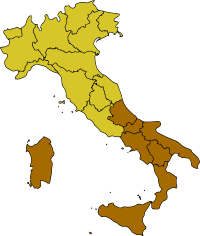
Photo from wikipedia
Val d’Agri is an important orchard area located in the Basilicata Region (Southern Italy). A phenomenon affecting cv. “Golden Delicious” apples which lead to tree death has been observed in… Click to show full abstract
Val d’Agri is an important orchard area located in the Basilicata Region (Southern Italy). A phenomenon affecting cv. “Golden Delicious” apples which lead to tree death has been observed in the past several years in this area. This phenomenon has already been detected in about 20 hectares and is rapidly expanding. The symptoms observed were “scaly bark” and extensive cankers, mainly located in the lower part of the trunk, associated with wood decay. Dead plants ranged from 20% to 80% and, in many cases, trees were removed by farmers. In order to identify the causes of this phenomenon, investigations were started in autumn/winter 2019. In order to determine the possible causal agents, fungal and bacterial isolations, from symptomatic tissues, were performed in laboratory. Bacterial isolations gave negative results, whereas pure fungal cultures (PFCs) were obtained after 3–4 passages on potato dextrose agar (PDA) media. Genetic material was extracted from each PFC and amplified by PCR using three pairs of primers: ITS5/4, Bt2a/Bt2b and ACT-512F/ACT-783R. The amplicons were directly sequenced, and nucleotide sequences were compared with those already present in the NCBI GenBank nucleotide database. All isolated fungi were identified based on morphological features and multilocus molecular analyses. Neofusicoccum parvum, Diaporthe eres and Trametes versicolor were most frequently isolated, while Pestalotiopsis funerea, Phomopsis spp. and Diaporthe foeniculina were less frequently isolated. All nucleotide sequences obtained in this study have been deposited into the EMBL database. Pathogenicity tests showed that N. parvum was the most pathogenic and aggressive fungus, while Phomopsis sp. was demonstrated to be the less virulent one. All the investigated fungi were repeatedly reisolated from artificially inoculated twigs of 2-year-old apple trees, cv. “Golden Delicious”, and subsequently morphologically and molecularly identified. The role played by the above-mentioned fungi in the alterations observed in field is also discussed.
Journal Title: Plants
Year Published: 2022
Link to full text (if available)
Share on Social Media: Sign Up to like & get
recommendations!